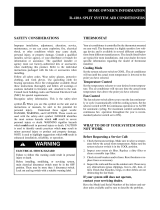
5
Air Ducts
This unit is designed only for use with a supply and return
duct. Air ducts should be installed in accordance with
the standards of the National Fire Protection Association
Standard for Installation of Air Conditioning Systems (NFPA
90A), Standard for Installation of Residence Type Warm Air
Heating and Air Conditioning Systems (NFPA 90B), and all
applicable local codes. NFPA publications are avaialable by
writing to: National Fire Protection Association, Batterymarch
Park, Quincy, ME 02269 or visit www.NFPA.org on the web.
• Designtheductworkaccordingtomethodsdescribedby
the Air Conditioning Contractors of America (ACCA).
• Theductsmustbeproperlysizedandnotexceed.2”W.C.
pressure drop at 400 scfm per nominal ton of cooling
capacity.
• Ductworkshouldbeattacheddirectlytotheunitanges
for horizontal applications.
• Ifroofcurbisinstalled,theductsmustbeattachedtothe
curb hangers, not the unit.
Unconditioned Spaces
All duct work passing through unconditioned space must
be properly insulated to minimize duct losses and prevent
condensation. Use insulation with an outer vapor barrier.
Refer to local codes for insulation material requirements.
Acoustical Duct Work
Certain installations may require the use of acoustical lining
inside the supply duct work.
• Acoustical insulation must be in accordance with the
current revision of the Sheet Metal and Air Conditioning
Contractors National Association (SMACNA) application
standard for duct liners.
• DuctliningmustbeULclassiedbattsorblanketswitha
fire hazard classification of FHC-25/50 or less.
• Fiberduct work may be usedin place of internal duct
liners if the fiber duct work is in accordance with the
current revision of the SMACNA construction standard
on fibrous glass ducts. Fibrous duct work and internal
acoustical lining must be NFPA Class 1 air ducts when
tested per UL Standard 181 for Class 1 ducts.
GENERAL INFORMATION
Packaged Air Conditioner units are ready for easy and
immediate installation on rooftops or ground level slabs. Units
are shipped for horizontal duct connections and can be easily
converted for downflow applications. This air conditioner is
designed only for outdoor installations.
This unit has been designed and tested for capacity and
efficiency in accordance with AHRI Standards. This unit
will provide many years of safe and dependable comfort,
providing it is properly installed and maintained. With regular
maintenance, this unit will operate reliably year after year.
Abuse, improper use, and/or improper maintenance can
shorten the life of the appliance and create unsafe hazards.
Pre - Installation Check
√ Before you install this unit, the cooling load of the area
to be conditioned must be calculated and a system of
the proper capacity selected. It is recommended that the
area to be conditioned be completely insulated and vapor
sealed.
√ Check the electrical supply and verify the power supply
is adequate for unit operation. If there is any question
concerning the power supply, contact the local power
company.
√ All units are securely packed at the time of shipment and
upon arrival should be carefully inspected for damage prior
to installing the equipment at the job site. Verify coil fins
are straight. If necessary, comb fins to remove flattened
or bent fins. Claims for damage (apparent or concealed)
should be filed immediately with the carrier.
√ Please consult your dealer for maintenance information
and availability of maintenance contracts. Please read
all instructions before installing the unit.
Locating the Air Conditioner
• Survey the job site to determine the best location for
mounting the outdoor unit.
• Chooseanappropriatelocationthatminimizesthelength
of the supply and return air ducts.
• Avoidoverheadobstructions,poorlyventilatedareas,and
areas subject to accumulation of debris.
• Sufcientclearanceforunobstructedairowthroughthe
outdoor coil must be maintained in order to achieve rated
performance. See
Figure 2 for minimum clearances to
obstructions.
Field Connections for Electrical Power
Supply
• All wiring must comply with current provisions of the
National Electrical Code (ANSI/NFPA 70) and with
applicable local codes having jurisdiction.
• The minimum size of electrical conductors and circuit
protection must be in compliance with information listed
on the outdoor unit data label.
• Electricalpowersuppliedtotheunitmustbeadequatefor
proper operation of the equipment. The system must be
wired and provided with circuit protection in accordance
with local building codes.
Minimum Required
Clearances to Obstructions
0"
36"
36"
36"
TOP OF UNIT
TO BE
UNOBSTRUCTED
36” For Coil Only
Figure 2. Clearance Requirements
















